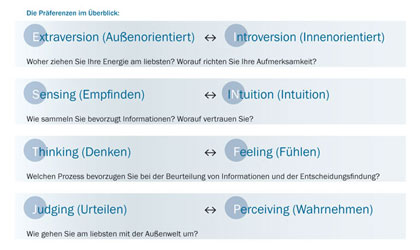Teambuilding in a different way: Forming a Crew out of some Group…by the MBTI
Using own strengths – detecting blind spots – knowing, how every type of personality recovers in times of stress in the best way.
From our experience the MBTI is a helpful tool for teambuilding. It can help to build a more effective communication and to find transparency about every one`s strengths and decision behavior.
A process of teambuilding can be founded completely on the MBTI by intensive work with common behavior patterns in daily life, reflection of different behavior in a team and working out solutions together.
After 50 years of research, the MBTI is the most common globally used tool for identifying differences in personalities.
It has been translated into 30 languages. 3.5 million assessments of this indicator are made annually. Katharine
Cook Briggs (1875 – 1968) and her daughter Isabel Briggs Myers (1897–1980) developed the MBTI in its current form on the basis of the work of Carl G. Jung (1875 – 1961). The model focuses on how people receive information and how they make decisions. Differences in the psychological functions preferred, employed and evidenced by individuals indicate certain fundamental differences between human beings, with 16 possible types crystallizing as a result.
When it comes to developing effective communication, achieving transparency regarding the strengths of each individual
and gaining an understanding of decision-making processes, MBTI is an extraordinarily helpful team development tool.
Whether it is a matter of team development or individual coaching, the MBTI
Type Indicator can be used by the group as a whole during team development
or by every participant alone at home. We provide the questionnaire containing 88 questions in digital and print form. We report the results to every participant in the form of a so-called best-fit conversation. Participants discover their own personality type with its strengths and developmental potential. They know what impression they make on others in regard to their type and what is important for them in interacting with others. A team development process can be built on the MBTI model completely by working on mutual behavior preferences in everyday work, reflecting on different behavior patterns and exploring solutions for mutual interaction.

